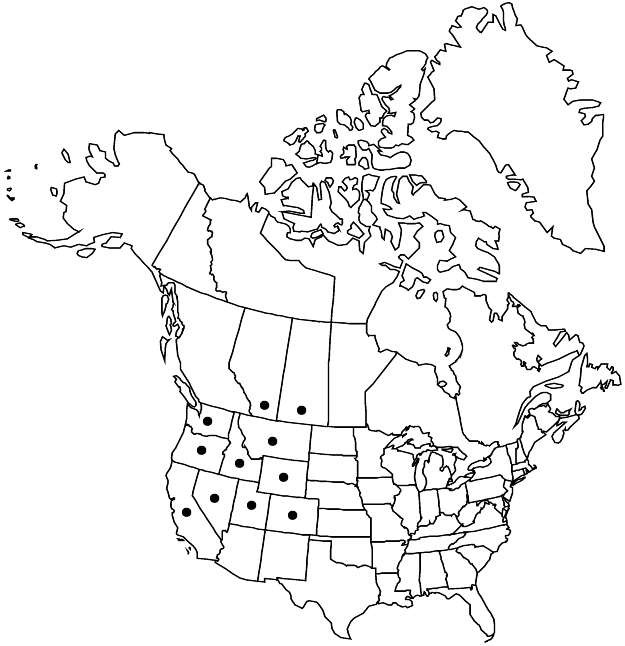Eremogone congesta
Novosti Syst. Vyssh. Rast. 10: 139. 1973.
Plants tufted or sometimes matted, green, not glaucous, with woody base. Stems ± erect, 3–40 (–50) cm, glabrous or often stipitate-glandular. Leaves: basal leaves persistent or not; cauline leaves in 3–5 pairs, similar, but reduced distally; basal blades erect-ascending to arcuate-spreading, subulate or needlelike to filiform, (0.8–) 2–11 (–14) cm × 0.4–2 mm, flexuous or rigid, herbaceous to ± fleshy, apex obtuse to sharply acute or spinose, glabrous, sometimes glaucous. Inflorescences 3–50+-flowered, congested and capitate or sometimes open, umbellate cymes. Pedicels 0.1–7 (–15) mm or ± absent, usually glabrous, rarely stipitate-glandular. Flowers: sepals 1–3-veined, sometimes obscurely so, ovate to lanceolate, 3–6.5 mm, not expanding in fruit, margins narrow, apex obtuse or acute to acuminate, rarely spinose, glabrous (or glandular in var. prolifera); petals white, oblong, 5–8 (–10) mm, 1.5–2 times as long as sepals, apex entire to slightly emarginate; nectaries as lateral and abaxial mound with crescent-shaped groove at base of filaments opposite sepals, 0.3 × 0.15–0.2 mm. Capsules 3.5–6 mm, glabrous. Seeds reddish-brown to black, broadly ellipsoid to ovoid, 1.4–3 mm, tuberculate; tubercles low, rounded, often elongate.
Distribution

Alta., Sask., Calif., Colo., Idaho, Mont., Nev., Oreg., Utah, Wash., Wyo.
Discussion
Varieties 9 (9 in the flora).
Eremogone congesta is highly polymorphic; it has been been divided into 11 varieties (nine recognized here), most of which are distinctive and locally distributed. M. F. Baad (1969) noted two patterns of variation of different origin within E. congesta, but he did not present a revised classification.
While most specimens of the four varieties with dense inflorescences do not exhibit evident pedicels, the occasional plant does bear one or more pedicels to 1–2 mm, sometimes in secondary inflorescences.
Selected References
None.
Lower Taxa
Key
| 1 | Pedicels usually 0.1-0.2 mm or ± absent; inflorescences dense, tight cymes | > 2 |
| 1 | Pedicels 1-6(-15) mm; inflorescences somewhat to markedly open cymes or umbellate cymes | > 5 |
| 2 | Basal leaf blades filiform, 3-14 cm | > 3 |
| 2 | Basal leaf blades needlelike, 1-3.5 cm | > 4 |
| 3 | Inflorescences capitate, rounded cymes; sepal apices obtuse to rounded | Eremogone congesta var. congesta |
| 3 | Inflorescences capitate, pyramidal cymes; sepal apices narrowly acute to acuminate | Eremogone congesta var. cephaloidea |
| 4 | Sepals 5-6.5 mm, apex acute to acuminate; basal leaf blades herbaceous; California, Nevada | Eremogone congesta var. simulans |
| 4 | Sepals 3.5-4 mm, apex obtuse; basal leaf blades ± succulent; California, Oregon | Eremogone congesta var. crassula |
| 5 | Sepal apices obtuse | > 6 |
| 5 | Sepal apices acute to acuminate or spinose | > 7 |
| 6 | Inflorescences proliferating, ± loose cymes; bracts often not closely enveloping sepals; Alberta, Saskatchewan, Colorado, Idaho, Montana, Utah, Wyoming | Eremogone congesta var. lithophila |
| 6 | Inflorescences umbels, bracts clustered at umbel base; California | Eremogone congesta var. suffrutescens |
| 7 | Basal leaf blades (2-)3-8 cm, filiform; pedicels glabrous or sometimes stipitate-glandular (possible throughout range, true for Nevada populations); Idaho, Nevada, Oregon, Washington | Eremogone congesta var. prolifera |
| 7 | Basal leaf blades 0.5-2.5(-3.5) cm, needlelike or filiform; pedicels glabrous; California, Nevada, Utah | > 8 |
| 8 | Inflorescences proliferating, ± loose cymes; sepals 3.5-4.5 mm | Eremogone congesta var. subcongesta |
| 8 | Inflorescences capitate and often rounded, to subcongested, proliferating or open cymes; sepals 4.5-6.5 mm | > 9 |
| 9 | Sepals 4.5-5.5 mm, weakly to conspicuously 1-3-veined, apex spinose | Eremogone congesta var. charlestonensis |
| 9 | Sepals usually 5.5-6.5 mm, conspicuously 3-veined, apex acute to acuminate | Eremogone congesta var. simulans |